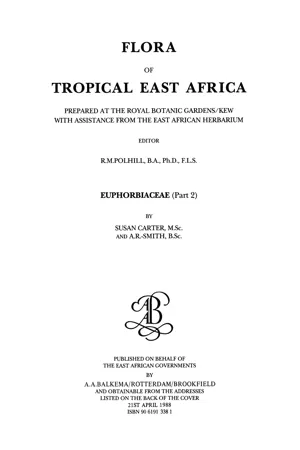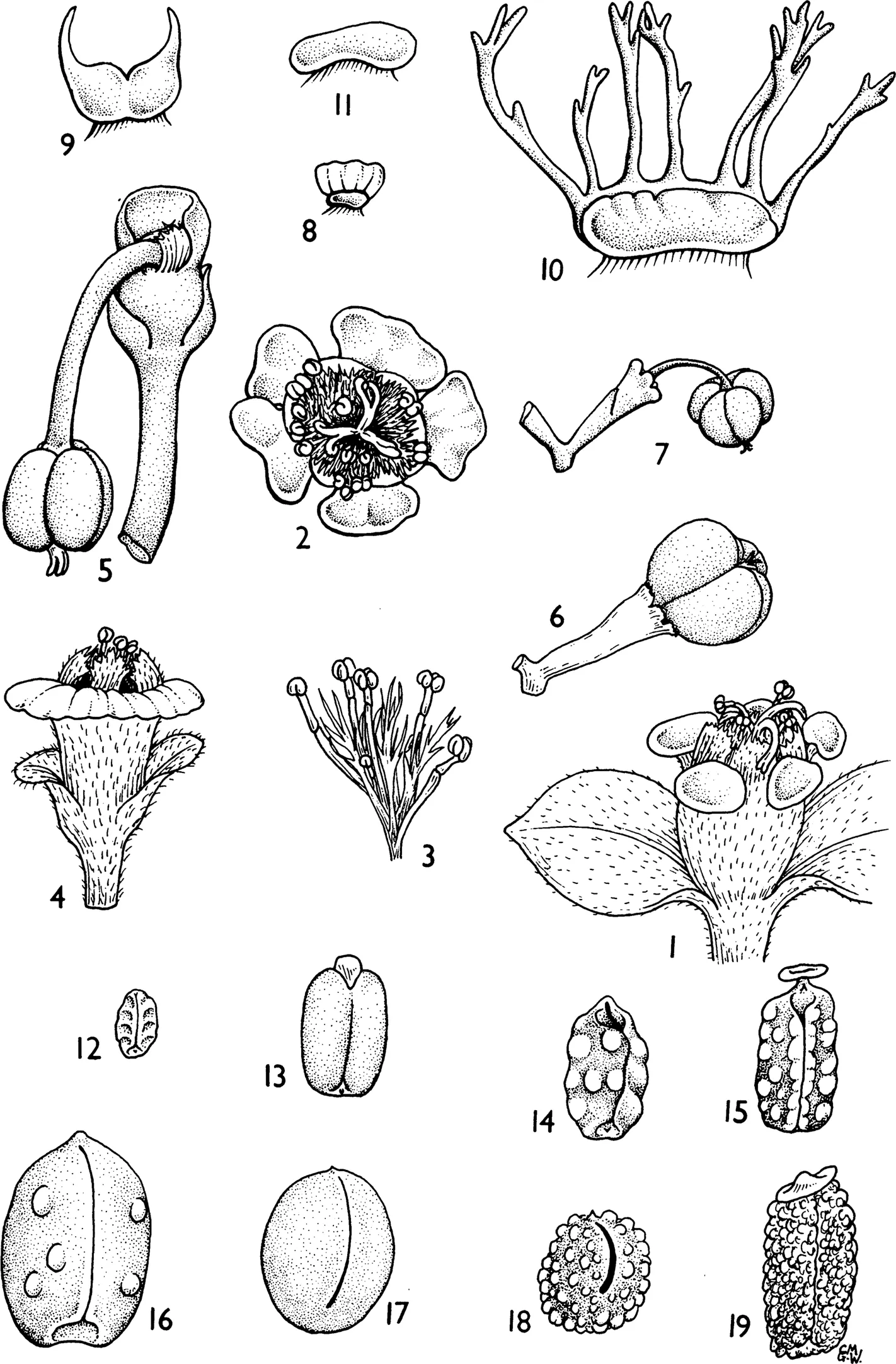
This is a test
- 192 pages
- English
- ePUB (mobile friendly)
- Available on iOS & Android
eBook - ePub
Flora of Tropical East Africa - Euphorbiac v2 (1988)
Book details
Book preview
Table of contents
Citations
About This Book
This volume focuses on the family Euphorbiaceae. They are well defined tribe which includes ten other small genera of tropical and sub-tropical regions. Euphorbia are annual, biennial or perennial herbs, shrubs or trees, sometimes succulent and unarmed or spiny, with a milky usually caustic latex.
Frequently asked questions
At the moment all of our mobile-responsive ePub books are available to download via the app. Most of our PDFs are also available to download and we're working on making the final remaining ones downloadable now. Learn more here.
Both plans give you full access to the library and all of Perlego’s features. The only differences are the price and subscription period: With the annual plan you’ll save around 30% compared to 12 months on the monthly plan.
We are an online textbook subscription service, where you can get access to an entire online library for less than the price of a single book per month. With over 1 million books across 1000+ topics, we’ve got you covered! Learn more here.
Look out for the read-aloud symbol on your next book to see if you can listen to it. The read-aloud tool reads text aloud for you, highlighting the text as it is being read. You can pause it, speed it up and slow it down. Learn more here.
Yes, you can access Flora of Tropical East Africa - Euphorbiac v2 (1988) by Susan Carter, A. R. Smith in PDF and/or ePUB format, as well as other popular books in Biological Sciences & Horticulture. We have over one million books available in our catalogue for you to explore.
Information
FLORA OF TROPICAL EAST AFRICA
______
EUPHORBIACEAE (Part 2)
SUSAN CARTER & A.R.-SMITH*
This part contains the tribe Euphorbieae, and also concludes with the treatments of those five genera (73. Bischofia, 74. Uapaca, 75. Antidesma, Hymenocardia (Hymenocardiaceae) & Microdesmis (Pandaceae)) about which there has been considerable dispute as to their familial status.
Tribe Euphorbieae
Boiss. in DC., Prodr. 15(2): 4(1862)
Flowers monoecious, with numerous ♂ flowers surrounding a solitary ♀flower and all enclosed within a cup-like involucre; each ♂flower reduced to a single pedicellate stamen without a perianth; ♀flower consisting of a pedicellate tricarpellary pistil with perianth absent or reduced to a rim or 3 lobes. Milky latex is always present.
A well-defined tribe which includes, besides the very large genus of Euphorbia itself, 10 other small genera of tropical and subtropical regions; of these 6 are endemic in tropical Africa, 3 occurring in East Africa (Elaeophorbia, Synadenium and Monadenium). Pedilanthus, from tropical America, is also used as an ornamental. KEY TO GENERA
KEY TO GENERA
| 1. Cyathia actinomorphic | 2 |
| Cyathia zygomorphic | 4 |
| 2. Gland continuous, rim-like, with no gap to one side | 70. Synadenium |
| Gland single, lateral, or glands 2-8, distinct | 3 |
| 3. Fruit not or only slightly fleshy, dehiscent | 68. Euphorbia |
| Fruit thick, fleshy, indehiscent, drupaceous | 69. Elaeophorbia |
| 4. Gland a continuous rim except for a gap at one side, surrounding the upper part of the cyathium | 71. Monadenium |
| Glands completely enclosed by the cyathium | 72. Pedilanthus |
L., Sp. Pl.: 450 (1753) & Gen. Pl., ed. 5: 208 (1754); Boiss. in DC., Prodr. 15(2): 78 (1862); G.P. 3(1): 258 (1800); N.E. Br. in F.T.A. 6(1): 470 (1911); Pax in E. & P. Pf., ed. 2, 19C: 208 (1931)
Annual, biennial or perennial herbs, shrubs or trees, sometimes succulent and unarmed or spiny, with a milky usually caustic latex, monoecious (elsewhere rarely dioecious). Roots fibrous, or thick and fleshy, sometimes tuberous. Leaves opposite, alternate or verticillate, often stipulate, subtended by spiny outgrowths on some succulent species. Inflorescence with cyathia in simple, dichotomous or umbellate terminal or axillary cymes; bracts paired, often leaf-like, sometimes brightly coloured and showy. Involucres with (1–)4–5(–8) glands around the rim alternating with 5 fringed lobes. Male flowers in 5 groups separated by fringed membranes, bracteolate. Female flower subsessile or with the pedicel usually elongating and reflexed in fruit but straightening before dehiscence; perianth reduced to a rim below the ovary, seldom 3-lobed; ovary 3-locular, with 1 pendulous ovule in each locule; styles 3, partly united. Fruit a capsule, sometimes fleshy but becoming woody at maturity, loculicidally and septicidally dehiscent (a regma). Seeds with or without a caruncle.
* Euphorbieae by Susan Carter, other genera by A.R.-Smith.

FIG. 76. Key characters. Cyathia of 1, Euphorbia, with glands distinct, 2, surface view, 3, stamens and bracteoles, 4, Synadenium, with glandular rim complete, 5, Monadenium, with glandular rim broken at one side. Capsules 6, sessile or subsessile, 7, exserted. Involucral glands of 8, Euphorbia subgen. Chamaesyce, 9, subgen. Esula, 10, subgen. Trichadenia, 11, subgen. Euphorbia. Seeds of 12, Euphorbia subgen. Chamaesyce, 13, subgen. Esula, 14, subgen. Eremophyton sect. Pseudacalyplza, 15, sect. Eremophyton, 16, subgen. Trichadenia, 17, subgen. Lyciopsis, 18, subgen. Euphorbia, 19, Monadenium. Drawn by Christine Grey-Wilson.
Euphorbia is one of the largest genera of flowering plants, with possibly over 2000 species and a world-wide distribution in temperate and tropical zones. About 1300 species are herbaceous. The other shrubby, tree and succulent species are confined almost entirely to the tropics and subtropics. With relatively few exceptions the succulent species, numbering over 500, occur in drier regions of the African continent (including Madagascar), well adapted to survive in often extreme xerophytic conditions. Their growth habit is extremely diverse, from small herbs to shrubs and large trees.
A number of species possessing showy leaves or bracts are of horticultural value, those introduced into East Africa including the well-known E. pulcherrima Klotzsch (Poinsettia) from Central America and E. milii Des Moulins from Madagascar (see notes on Cultivated Species, p. 413). All the succulent species are of interest to specialist collectors, many being at risk in the wild and listed as endangered. The lightweight wood of some tree species has occasionally been used commercially for such items as matchsticks and banana crates.
The latex of all species is abundant and usually caustic, sometimes exceedingly so. Because of this and its irritant qualities, it is often a component, in Africa, of arrow and fish poisons, and is used widely in native medicines. As such it is known occasionally to promote some forms of cancer and consequently its chemical properties are of importance in cancer research. Attempts have been made in the past to use the latex as a rubber substitute, but resulting compounds proved to be unstable. Currently some species are being investigated for their hydrocarbon content as a source of fuel.
Because of the unifying structure of the cyathium, classification of this large and otherwise diverse aggregate of species has always been difficult and no system proposed so far has proved entirely satisfactory. Some authors have separated Euphorbia into a number of genera, with reasons usually based upon slight peculiarities of the cyathial structure. As treatment is often confined to limited geographical areas, such concepts invariably break down when applied to related species from other regions. The arrangement employed here loosely follows Pax’s adaptation (1931) of Boissier’s work (1862), with modifications to better accommodate a number of distinct groups recognized within East Africa. These are placed in subgenera and sections in a sequence which is not strictly phylogenetic but shows increasing specialization towards succulence, and a synopsis of which follows.
SYNOPSIS OF SUBGENERA AND SECTIONS
Subgen. Chamaesyce Raf. in Amer. Month. Mag. 2:119 (1817). Principally of New World origin and regarded by some authors as an easily defined genus with several distinguishing and often advanced characters. Its main stem is reduced, the entire plant at maturity consisting of an expanded dichotomously branching pseudumbellate inflorescence, with the floral bracts assuming the appearance and function of normal leaves. Stipules are obvious, the 4 involucral glands bear petaloid appendages on the outer margin and the seeds are ecarunculate.
Sect. Hypericifoliae Pojero, Fl. Sicula 2(2): 327 (1907). Includes species with 10 or more cyathia grouped or congested into often capitate cymes, and of which there are 3 introduced species in East Africa. Species 1–3.
Sect. Chamaesyce. Includes species with solitary cyathia or a few clustered in leafy cymes. Species 4–22.
Subgen. Poinsettia (Grah.) House in Bull. N. York St. Mus. 254: 472 (1924). Syn. — Poinsettia Grah. in Edinb. New Philos. Journ. 20: 412 (1836). Also of New World origin and often regarded as a separate genus. Large floral bracts and a distinctive single funnel-shaped involucral gland. 2 herbaceous species have been introduced and become naturalized in East Africa. Species 23, 24.
Subgen. Esula Pers., Syn. Pl.: 14 (1806). Generally (not always) accepted as the most primitive, although its species possess some characters more advanced than those of many others in Africa, such as the development of an herbaceous habit, loss of stipules and a condensed pseudumbellate inflorescence. It has diversified as a group especially in temperate zones to become possibly the subgenus with the largest number of species. All indigenous East African species belong to sect. Esula, with leafy bracts, 4 involucral glands and carunculate seeds. Species 25–35.
Subgen. Eremophyton (Boiss.) Wheeler in Amer. M...
Table of contents
- Cover
- Title Page
- Copyright Page
- Euphorbiaceae (Part 2)
- Hymenocardiaceae
- Pandaceae
- Index to Euphorbiaceae
- Geographical Divisions of the Flora